
Cedrus atlantica, the Atlas cedar, is a species of tree in the pine family Pinaceae, native to the Rif and Atlas Mountains of Morocco, and to the Tell Atlas in Algeria. A majority of the modern sources treat it as a distinct species Cedrus atlantica, but some sources consider it a subspecies of Lebanon cedar.
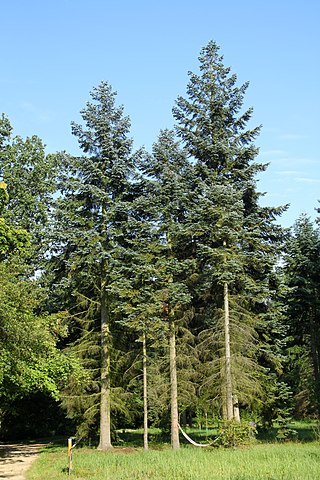
Abies procera, the noble fir, also called red fir and Christmas tree, is a species of fir native to the Cascade Range and Pacific Coast Ranges of the northwestern Pacific Coast of the United States. It occurs at altitudes of 300–1,500 meters (980–4,920 ft).
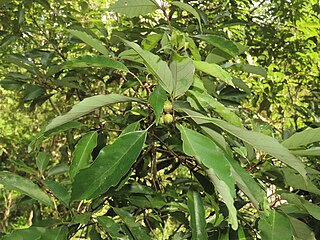
Quercus glauca, commonly called ring-cupped oak or Japanese blue oak, is a tree in the beech family (Fagaceae). It is native to eastern and southern Asia, where it is found in Afghanistan, Bhutan, China, northern and eastern India, southern Japan, Kashmir, Korea, Myanmar, Nepal, and Vietnam. It is placed in subgenus Cerris, section Cyclobalanopsis.

Carex flacca, with common names blue sedge, gray carex, glaucous sedge, or carnation-grass,, is a species of sedge native to parts of Europe and North Africa. It is frequent in a range of habitats, including grasslands, moorlands, exposed and disturbed soil, and the upper edges of salt marshes. It has naturalized in eastern North America.
Glaucous is used to describe the pale grey or bluish-green appearance of the surfaces of some plants, as well as in the names of birds, such as the glaucous gull, glaucous-winged gull, glaucous macaw, and glaucous tanager.

Nothofagus glauca, commonly known as hualo or roble Maulino, is a species of plant in the family Nothofagaceae. It is a deciduous tree endemic to Chile. It grows from 34° to 37° South latitude. It is a typical tree of the maritime mediterranean-climate Maulino forest of Central Chile, its current range spanning over 330 km from north to south. The species grows on a variety of soils and is mostly found on gentle to steep slopes.

Tauschia is a genus of flowering plants in the carrot family which are known as umbrellaworts. These are perennial plants with taproots or tubers and foliage generally resembling that of relatives parsley and carrot. Tauschia are native to the Americas.

Arctostaphylos glauca is a species of manzanita known by the common name bigberry manzanita. It is native to California and Baja California, where it grows in the chaparral and woodland of coastal and inland hills.

Agoseris glauca is a species of flowering plant in the family Asteraceae known by the common names false dandelion, pale agoseris, prairie agoseris, and short-beaked agoseris. It is native to western North America.

Smilax glauca, the cat greenbriar or catbriar, is a woody vine in the family Smilacaceae. It is native to central and eastern portions of the United States as well as Mexico, where it is a common and conspicuous part of the forest vegetation.

Poa glauca is a species of grass known by the common names glaucous bluegrass, glaucous meadow-grass and white bluegrass. It has a circumboreal distribution, occurring throughout the northern regions of the Northern Hemisphere. It is also known from Patagonia. It is a common grass, occurring in Arctic and alpine climates and other areas. It can be found throughout the Canadian Arctic Archipelago in many types of habitat, including disturbed and barren areas.

Tauschia arguta is a species of flowering plant in the carrot family known by the common name southern umbrellawort. It is native to the mountains of southern California and Baja California, where it grows in local habitat types such as woodlands and chaparral.
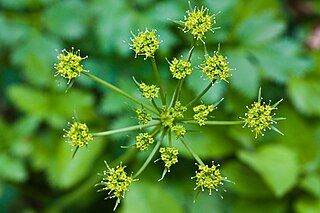
Tauschia hartwegii is a species of flowering plant in the carrot family known by the common name Hartweg's umbrellawort. It is endemic to California, where it is known from the Sierra Nevada foothills and some of the Central Coast Ranges. Its habitat includes coniferous woodlands and chaparral. It is a perennial herb growing 30 centimeters to one meter tall. It is coated in short, rough hairs. The leaves have blades which are divided into oval leaflets with serrated edges and borne on long petioles. The inflorescence is a compound umbel of yellow flowers with up to 30 unequal rays measuring 2 to 12 centimeters long each. The fruit is somewhat rounded in shape, ribbed, and under a centimeter long.
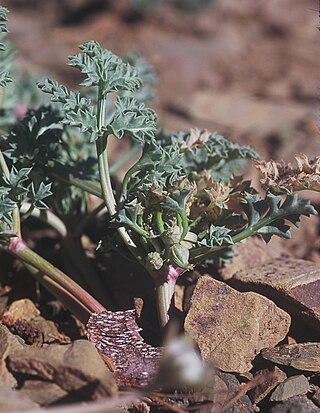
Tauschia howellii is a rare species of flowering plant in the carrot family known by the common names Howell's umbrellawort and Howell's tauschia. It is endemic to the Klamath Mountains of far southern Oregon and far northern California, where it is limited to nine occurrences in the Siskiyou Mountains. It grows in mountain forests on gravelly granite soils, often among stands of Shasta red fir. Despite its rarity it is stable and not considered very endangered. It is a perennial herb growing 30 to 80 centimeters tall. It is hairless in texture. The thick leaves have blades which are divided into leaflets large, sharp teeth and edges curved up, and borne on long petioles. The short inflorescence is a compound umbel of yellow flowers on a few short rays. The fruit is oblong, ribbed, and just a few millimeters long.
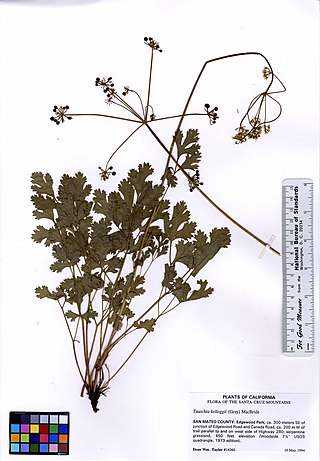
Tauschia kelloggii is a species of flowering plant in the carrot family known by the common name Kellogg's umbrellawort. It is native to the mountains of Oregon and the northern half of California, where it grows in chaparral, woodlands, forest, and other types of habitat. It is a perennial herb growing up to 70 centimeters tall. The leaves have blades which are divided into toothed or serrated leaflets, and sometimes subdivided further. The inflorescence is a compound umbel of yellow flowers with 10 to 20 rays measuring 2 to 12 centimeters long each. The fruit is somewhat rounded in shape, ribbed, and up to half a centimeter long.
Tauschia parishii is a species of flowering plant in the carrot family known by the common name Parish's umbrellawort. It is endemic to California.

Gentiana glauca is a species of flowering plant in the gentian family known by the common names pale gentian and glaucous gentian. It is native to eastern Asia and northwestern North America from Alaska to the Northwest Territories to Washington and Montana.

Melaleuca glauca, commonly known as Albany bottlebrush is a plant in the myrtle family, Myrtaceae and is endemic to the south-west of Western Australia. It is a tall shrub with glaucous leaves and spikes of red flowers in spring.
Goodenia glauca, commonly known as pale goodenia, is a species of flowering plant in the family Goodeniaceae and is endemic to the drier inland areas of eastern continental Australia. It is a glaucous, erect, ascending perennial herb with lance-shaped to elliptic leaves and racemes of pale yellow flowers.
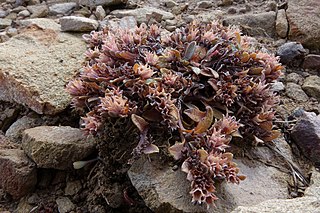
Myosotis glauca is a species of flowering plant in the family Boraginaceae, endemic to the South Island of New Zealand. George Simpson and J.S. Thomson described M. pygmaea var. glauca in 1942, and Peter de Lange and John Barkla recognized it at species rank in 2010. Plants of this species of forget-me-not are perennial with a prostrate habit, bracteate inflorescences, white corollas, and often glaucous grey leaves.
















